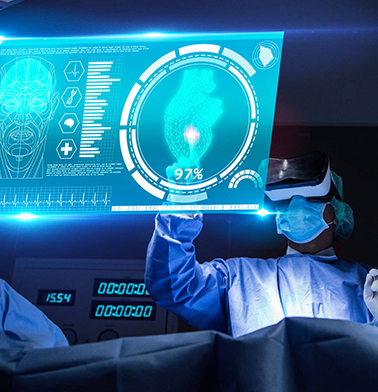The healing touch of Digital Reality
Healthcare is one of the few industries where the stakes of service are real and high, as it is connected to the human life. And over the years, the effectiveness of the healthcare service has massively risen due to the applications of advanced technology. Keeping in mind the technology trend in healthcare and the public interest at large, Immersive technologies like AR, VR and MR fit effortlessly into the health ecosystem. These technologies are increasingly being used to enhance the efficacy and quality of the existing medical procedures, as well as improve the capabilities of the professionals involved.
The rise of Immersive technology in Healthcare
Not only have immersive technologies bolstered the way diagnosis, treatment and medical training is conducted, but also have created a consequential market for technology in healthcare. The AR and VR healthcare market in 2018 was valued at $0.6 billion, which is projected to grow to $5.1 billion by the year 2025, expanding at a CAGR of 29.1%. Furthermore, Augmented reality contributed an incredible 56.42% to market shared in 2018 and is expected to rise at a CAGR of 33.91% during the forecasted period. On the other hand, the Virtual Reality segment contributed 43.58% in 2018 to the market and is projected to grow at a CAGR of 28.15%. Regionally, North America was the largest contributor to the AR and VR healthcare market with $477.2 million in 2018 and is projected to grow at a CAGR of 30.56% to an estimated value of $4.64 billion.


Augmented and Virtual reality healthcare solutions
These numbers affirm that Immersive technology in the health industry is a growing phenomenon, capable of offering efficient and innovative solutions to the challenges faced along with multiple implementation opportunities. Augmented reality enables visualization of patient’s health data via smart glasses in the form of live statistics appearing on the patient’s body, which helps in pointing out problematic areas. This helps the medical fraternity in advanced and timely diagnosis of the patient’s diseases and reduce the subsequent risk. Additionally, body mapping enables recreation of a patient’s body in 3D using AR applications when a doctor or surgeon is only remotely available. Another crucial application of augmented reality is real-time hospital navigation to locate the right equipment or room in case of an emergency.
Medical training has been made effective with Simulation as students no longer need to participate in operations guided by professional surgeons which usually means limited access. Virtual really creates realistic simulation systems and environments where medical students can gain first-hand experience without putting the patient’s life at risk. Furthermore, VR is enabling medical researchers to understand cancer by mapping out individual body cells in a virtual environment, in a bid to achieve breakthrough with the cure. Virtual reality also helps with pain management to a great extent by repeated VR exposures to distract patients from the pain. For patients suffering from post-operative delirium a VR headset is used to familiarise them with the surgical process that reduces the confusion when they wake up. Virtual reality is also helping patients recover from brain injuries by helping them cope with everyday tasks in a virtual environment. Moreover, VR is helping the medical professionals in developing socials skills of autism patients, reduce the symptoms of depression, heal veterans who are dealing with PTSD, treating phobias, timely detection of Alzheimer’s and ascertaining early signs of schizophrenia.
The way forward for the Healthcare industry with EDIIIE
The potential of Digital reality in the healthcare sector is huge, limited only by the ingenuity and creativity of the developers. At EDIIIE we are constantly striving to surpass the stakes by developing accurate and explicit tools that enable breakthroughs in the way treatment and diagnosis is done in the medical field.







.png)































